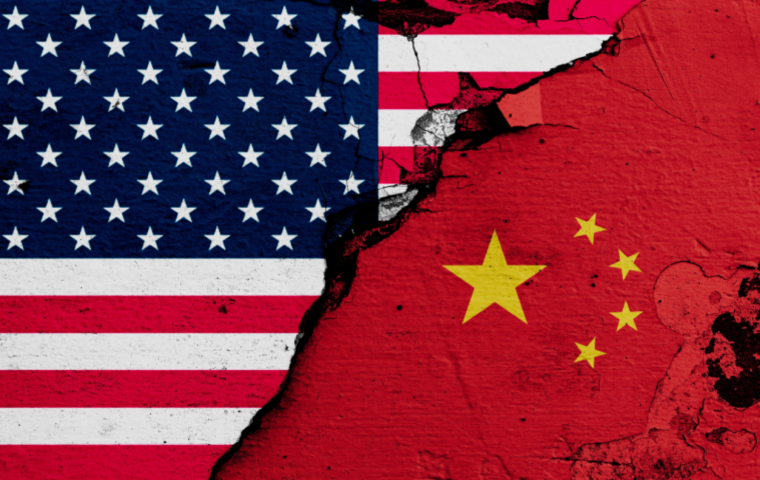Make China Play by the Rules; Could Be Better than Sanctions (#1)
Related Articles

According to the theory of economic growth, China is still an emerging country and lacks the conditions for becoming a “hegemony.” The more pressing issue is how to prevent the U.S.-China strategic competition from escalating into war. An asymmetric power balance between a supreme power and an emerging nation could exacerbate the risk of a confrontation between the U.S. and China escalating into war.
The U.S.-China confrontation has been ongoing for some time, with the U.S. seeing Chinese industrial policy and technological dominance as problematic. Simply relying on sanctions to achieve the goal of “stopping unilateral changes to the status quo” may increase the risk of conflict. Instead, a safety net should be established to deter any acts of “unilateral change to the status quo” by cutting off those who engage in such acts from globalization.
Globalization Brought on Economic Growth
The figure illustrates the trend in GDP per capita since 1600, based on data compiled by economic historian Angus Maddison et al. In the economic growth model, GDP per capita growth is considered as economic growth, and under certain conditions, it is expected to converge towards a similar path. Until the nineteenth century, the U.K., as a superpower, had the highest GDP per capita, but the U.S. surpassed the U.K. in the twentieth century and became the hegemon after World War II. Although emerging countries Germany and Japan were on the trajectory to catch up with advanced nations like the U.K. and the U.S. in the first half of the twentieth century, they were still lagging behind and ended up waging war against the superpowers. Despite suffering defeat and losing national strength, the two countries soon began to follow the growth trajectory of advanced nations after they started to comply, rather than challenge, the international order and enjoyed the fruits of globalization. South Korea, Taiwan, Singapore, and Hong Kong followed the same path. However, Argentina and the Russian Federation, which were at levels similar to Japan and Germany before the war, deviated from the trajectory of advanced nations and fell into the “middle-income country trap.” China fell far behind the U.K. and the U.S. during the Qing Dynasty but began to catch up in the second half of the twentieth century. The current U.S.-China relations still reflect an advanced versus emerging country dynamic and not a rivalry between hegemonic powers.

GDP per capita growth is influenced not only by factors such as capital or labor, but also by Total Factor Productivity (TFP), which is known as an externality in economics. TFP includes technologies in the narrow sense and systems. The country’s chosen system, whether it is globalization or national isolation, market economy or communism, promoting competition or monopoly, determines the choice and application of technologies. These technologies, in turn, affect economic growth. Ultimately, it is politics that decides which system a country adopts. Therefore, economic growth is determined by how a nation utilizes its technologies.
In the twenty-first century, digitalization has emerged as the technology with the potential to boost GDP per capita. This technology involves using software to run computers, which enables automatic decision-making and remote operations. The semiconductor supports signal transmission from the software to the computer. Algorithms have also evolved into artificial intelligence (AI) by analyzing vast amounts of data to improve their performance. Additionally, advancements in data communication between terminals and servers have made tasks such as mobile payments and automated driving that transcend space possible.
It is widely acknowledged that digitalization technologies, such as satellites and drones, have played a significant role in the ongoing battles that started with the Russian invasion of Ukraine.
China’s Industrial Policy and Advanced Technologies
China’s turnaround began in 1978 when Deng Xiaoping launched the Reform and Opening-up policy, setting the country on a path towards catching up with advanced economies. Globalization and free-market economy contributed to nurturing the Total Factor Productivity (TFP) in China. Joining the World Trade Organization (WTO) in 2001 further linked China’s domestic systems to those in the West, and paved the way for private companies to compete with state-owned enterprises. In addition, the 11th Five-Year Plan (2006) introduced measures to promote the selected industries, while the 12th Five-Year Plan (2011) focused on catching up in the manufacturing sector by selecting “strategic pillar industries.” The 13th Five-Year Plan (2016) launched “Made in China 2025” and “Internet+” plans to integrate the digitalization of the existing manufacturing and service sectors, aiming to boost the competitive strength of the Chinese manufacturing industry to global standards.
In the 14th Five-Year Plan from 2021, China has set the objective of building “Digital China.” This marks a shift from the previous catch-up industry policies, and presents a blueprint for advancing technology. Under the pretext of a big data industry policy, the Ministry of Industry and Information Technology has established a system for creating a market for trading data, and Shenzhen has announced its AI industry policy. Additionally, there are plans for the “East-Data-West-Computing” public work project for digitalization, which involves sending data from the densely populated east coast area to servers in the underpopulated western areas for storage and calculation.
However, China’s current spending on semiconductor imports is four times the amount it pays for oil. This means that the value of imports for goods such as semiconductors, which can be produced domestically if the nation holds sufficiently high technology, exceeds the value of imports for natural resources that are subject to geographical limitations. This highlights the fact that China is still an emerging country and not an advanced one, as it has yet to become self-sufficient in its advanced technologies. Merely having a high gross GDP is not enough, as China must also increase its GDP per capita to to become a truly strong and sustainable economy. In times when global competition becomes tougher and China seeks to reduce its reliance on external relations, it often emphasizes its focus on science and technology. The idea is to offset the costs of closing its doors with non-commercial technologies. However, simply focusing on science and technology alone may not be enough for China to sustain its economic growth in the long term.
Continues in #2
This is a translation of the Japanese article published in vol. 76 (Nov./Dec. 2022) of the Gaiko (Diplomacy) magazine.
Mariko Watanabe has been a professor at Gakushuin University since 2013. She graduated from the University of Tokyo in 1991 and joined the Institute of Developing Economies (IDE). After serving as a visiting scholar at the Guanghua School of Management, Peking University, she became the Director of the East Asian Studies Group, Area Studies Center of IDE. She has earned a M.Phil. from the School of Business, University of Hong Kong and a Ph.D. in economics from the University of Tokyo. Her books include Chugoku no sangyo ha donoyou ni hattenn shitanoka [How Chinese Industries Developed] (author and editor) and Kokusai tsusho chitsujyo no chikaku hendou [Upheaval of International Trade Order], and Chugoku sozo taikoku he no michi [China’s Road to Creation Powerhouse] (co-author).




